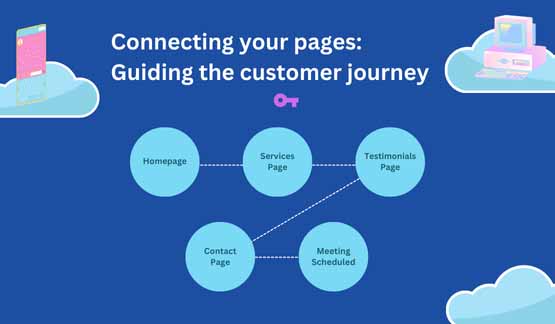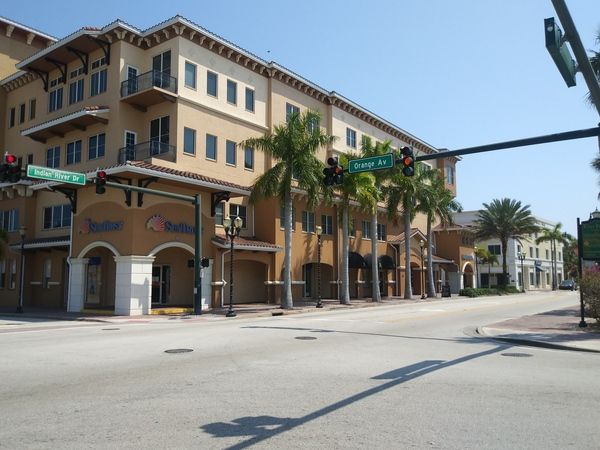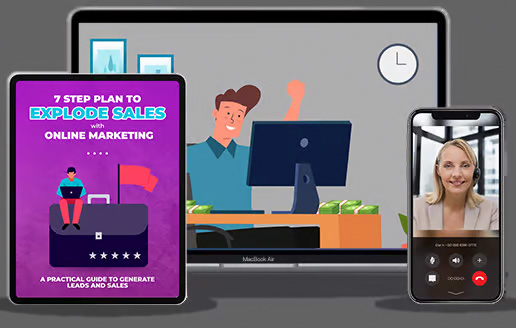Your website isn’t just a collection of individual pages—it’s a system where each page plays a specific role in achieving your business objectives. From driving actions to building trust, generating traffic, and supporting operations, every page must do its job while working seamlessly with the others.
In our previous article, What Pages Does Your Website Really Need? we explored the types of pages your website might include and how they align with specific business goals. But understanding what pages you need is only part of the equation. To truly unlock your website’s potential, you need to understand how those pages work together as part of a cohesive system.
A well-structured website doesn’t just look good; it creates clear paths for users to follow, integrates with your external marketing efforts, and guides visitors from one stage of their journey to the next. In this article, we’ll dive into how information architecture shapes your website, how pages flow into one another, and how they connect with campaigns like advertising, SEO, and email marketing to deliver results.
Let’s explore how to design a website that works as a unified whole to support both your users and your business goals.
Optimizing for User Journey and Business Goals
A successful website is more than a collection of pages—it’s a cohesive system designed to guide users through a seamless journey, aligning their needs with your business objectives. By focusing on the user’s experience and providing clear, intuitive paths, your website becomes a powerful tool for achieving real outcomes.
Balancing User Needs and Business Objectives
At its heart, your website exists to serve two purposes:
- Satisfying user needs, like finding answers, learning about your offerings, or completing a purchase.
- Meeting business objectives, such as generating leads, making sales, or building brand loyalty.
When these two purposes are balanced, users feel supported, and your business thrives. For example:
- A blog post might address a user’s immediate question while gently guiding them to a landing page where they can learn more or take the next step.
- A product page might highlight features and benefits, while also making the path to purchase simple and obvious.
This balance ensures that your website serves its visitors while also driving meaningful results for your business.
Creating Clear, Intuitive Paths
The user journey should feel effortless. Every page on your site should have a clear purpose and connect logically to the next step, minimizing friction and confusion.
- Example Path:
- A visitor lands on your blog via a search engine.
- The blog includes a call-to-action for a free downloadable guide.
- Clicking the CTA leads to a landing page where they provide their email to access the guide.
- From there, the visitor receives a follow-up email inviting them to a webinar or consultation.
This seamless flow ensures users are always moving closer to taking meaningful actions that align with your business goals.
Eliminating Friction
Friction is anything that disrupts the user journey—confusing navigation, unnecessary steps, or misaligned expectations. Reducing friction ensures users stay engaged and complete their journey.
- How to Identify Friction Points:
- Review pages with high bounce rates or low conversions.
- Conduct usability testing to understand user challenges.
- Analyze feedback and behavior data for insights.
- How to Reduce Friction:
- Streamline forms and make CTAs clear and visible.
- Design pages to be clean and focused, with minimal distractions.
- Ensure the path between pages feels natural and intuitive.
Aligning Pages With the Customer Value Journey
Your website should cater to users at every stage of their journey:
- Awareness: Pages like blogs and resources attract new visitors and introduce your brand.
- Engagement: About pages, FAQs, and resource hubs build trust and provide value.
- Conversion: Landing pages, product pages, and checkout flows drive specific actions.
- Advocacy: Testimonial pages, referral programs, and community forums turn customers into advocates.
By designing your site around these stages, you create a system that not only guides users but also maximizes ROI.
The Flow Between Pages
A website functions as a system, with each page contributing to the overall user journey. The way pages connect and support one another determines how effectively your site drives users toward your business goals. These connections are where your website’s real power lies—transforming isolated pages into a cohesive, purpose-driven experience.
Engagement Pages Leading to Action Pages
Engagement pages, like blog posts, resource hubs, or FAQs, serve as the starting points for many users. They provide value, build trust, and create curiosity, but their ultimate purpose is to guide users toward action-oriented pages.
- Example Flow:
- A user searches for “How to improve email marketing ROI” and lands on your blog post.
- The post includes an invitation to download a free guide with advanced strategies, linked to a landing page.
- The landing page collects the user’s email in exchange for the guide, bringing them into your sales funnel.
This connection ensures that engagement doesn’t end in a dead-end but instead advances the user along their journey.
Action Pages Driving Conversions
Pages like landing pages, product pages, and checkout flows are the engines of conversion. But these action-oriented pages rely on context and momentum created by engagement pages and external marketing efforts.
- Example Flow:
- A Facebook Ad offers a free trial of your software, directing users to a landing page.
- The landing page provides compelling reasons to sign up and collects the user’s details.
- After the trial, an email campaign leads the user to a checkout page to purchase the full product.
Every action page builds on the trust and interest generated earlier, ensuring users are primed to convert.
Operational Pages Reducing Friction
While operational pages like FAQs, help centers, or privacy policies aren’t designed to convert users directly, they play a vital role in supporting the journey. These pages address user concerns and eliminate obstacles, allowing users to move forward with confidence.
- Example Flow:
- A potential customer is unsure about shipping costs and visits your FAQ page.
- The FAQ provides the clarity they need, with a link back to the product page.
- Reassured, the customer completes their purchase on the checkout page.
Operational pages act as the safety net that ensures no user’s journey is cut short by uncertainty or unanswered questions.
Advocacy Pages Feeding Back Into the System
Pages like testimonial pages, referral programs, and community forums turn satisfied customers into advocates. These pages don’t just enhance trust—they bring new users into the system, restarting the journey for others.
- Example Flow:
- A satisfied customer submits a testimonial, which you feature on your testimonial page.
- A new visitor, inspired by the testimonial, clicks through to a landing page offering a free consultation.
- The new visitor converts, completing the cycle and growing your customer base.
Advocacy pages are the bridge between satisfied customers and new opportunities, creating a self-sustaining system of growth.
Integrating Marketing and External Efforts
Your website is the centerpiece of your digital strategy, but it doesn’t operate alone. It works in harmony with your advertising campaigns, SEO efforts, email marketing, and even offline initiatives. For this ecosystem to thrive, your website pages must connect seamlessly with these external triggers, creating a unified experience that guides users toward your goals.
1. Advertising and Landing Pages
Paid advertising can drive targeted traffic to your site, but its success depends on what happens next. Landing pages are critical for converting ad traffic because they are purpose-built to deliver on the ad’s promise.
- Example: A Google Ad promoting a “Free Marketing Checklist” links directly to a landing page where users can download the checklist by entering their email. The page’s messaging, visuals, and offers, match the ad, ensuring a cohesive and satisfying user experience.
If there’s a mismatch between the ad and the landing page, visitors may lose trust and abandon the process, wasting your ad spend.
2. SEO and Engagement Pages
SEO helps attract organic traffic to your site by targeting user intent with valuable content. Pages like blog posts and resources are often optimized to rank highly on search engines, acting as the first touchpoint for users.
- Example: A blog post titled “Top 10 Strategies to Boost Your Social Media ROI” ranks on Google, attracting users searching for social media tips. The blog includes a call-to-action leading to a landing page where users can download an in-depth guide, seamlessly connecting organic traffic to a conversion opportunity.
When these pages are optimized with keywords, metadata, and clear paths to action, they serve as powerful tools for turning searchers into leads.
3. Email Campaigns and Lead Magnets
Email campaigns re-engage users who have already interacted with your site, guiding them back to take further action. Lead magnets—resources like eBooks, templates, or webinars—are often the focal point of these campaigns.
- Example: An email to your subscriber list offers access to an exclusive webinar on “Marketing Trends for 2025.” The email links to a registration page where users can sign up, entering your sales funnel.
The success of these campaigns depends on the strength of the pages they link to. Each page must align with the promise made in the email, ensuring users feel rewarded for their click.
4. Social Media and Shareable Content
Social media platforms are excellent for building awareness and driving traffic to your site. The key is ensuring that the pages users land on are optimized for engagement and conversion.
- Example: A LinkedIn post shares a case study on how your agency helped a client increase ROI by 200%. The post links to a detailed case study page, which includes a CTA inviting readers to schedule a consultation.
Shareable content must be visually appealing, easy to navigate, and compelling enough to keep users engaged.
5. Offline Efforts and Dedicated Pages
Even offline initiatives can benefit from targeted web pages. Flyers, QR codes, or in-person events often direct users to specific landing pages tailored to their needs.
- Example: A QR code on an event flyer links to a landing page offering exclusive discounts or free resources, tying your offline efforts directly to your digital strategy.
These pages ensure a seamless transition from the physical world to the digital, capturing offline interest and turning it into measurable results.
Why Integration Matters
When your website pages align with external efforts, they amplify each other’s impact. Advertising generates traffic, SEO builds awareness, email campaigns nurture leads, and social media drives engagement—but it’s your website that ties these efforts together and converts interest into outcomes.
Building the Right Pages for a Cohesive System
Achieving your business objectives isn’t just about creating a great landing page or optimizing for conversions—it’s about designing an intentional system of pages that guides users through every step of their journey.
Each page on your website has a purpose, whether it’s attracting visitors, engaging them with valuable content, or driving them to take action. But the real magic happens in the transitions—the paths that move users seamlessly from awareness to engagement, from consideration to conversion, and from satisfaction to advocacy.
To succeed, you need to:
- Build the Right Pages: Identify what your users need at every stage and create pages that meet those needs while supporting your business goals.
- Design Clear Paths: Ensure every page connects logically to the next, eliminating friction and guiding users forward with purpose.
- Integrate Efforts: Align your website with your broader marketing strategy, so every campaign works together to maximize impact.
When you design your website with intention—crafting the right pages and connecting them with clear, strategic paths—you create a system that not only achieves your objectives but also delivers an exceptional experience for your users.
Want to ensure your website works as hard as you do? Reach out to Blue Creek Digital, and let’s make your website one that drives measurable results, one page and one journey at a time.



